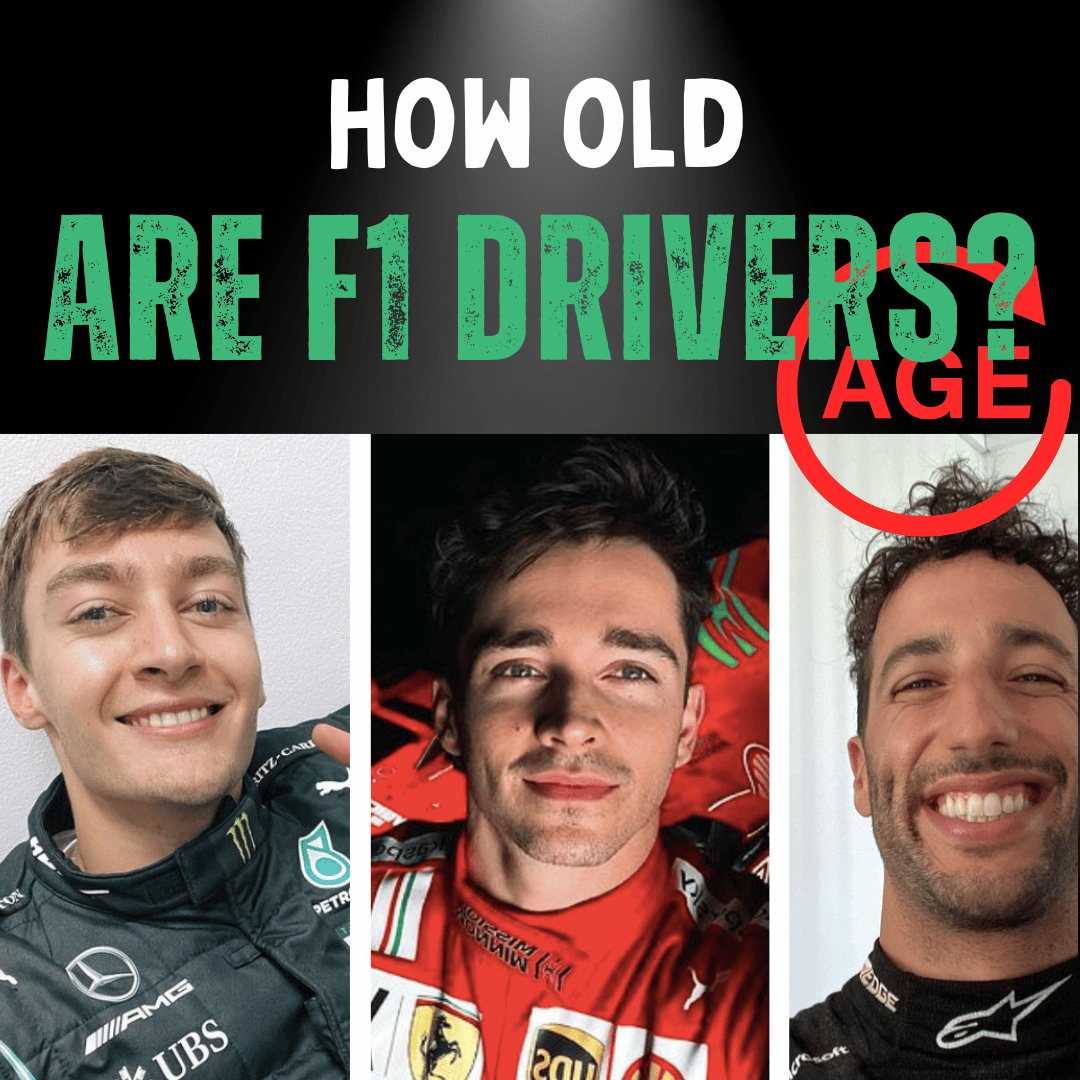Updated: 12.05.25
Ever wondered how old Formula 1 drivers are as they race at top speeds? From young talents to seasoned veterans, let’s explore the diverse age range of F1 drivers in 2025.
1. How Old Are F1 Drivers in 2025?

The average age of F1 drivers in 2025 is projected at 27 years, a slight dip from 27.6 in 2024, with a range from 18 to 43 years. This reflects a mix of youthful rookies and experienced veterans.
F1 Driver Ages in 2025
| Driver | Age |
|---|---|
| Fernando Alonso | 43 years old |
| Lewis Hamilton | 40 years old |
| Kevin Magnussen | 32 years old |
| Pierre Gasly | 29 years old |
| Alex Albon | 29 years old |
| Esteban Ocon | 28 years old |
| Charles Leclerc | 27 years old |
| Max Verstappen | 27 years old |
| George Russell | 27 years old |
| Lance Stroll | 26 years old |
| Lando Norris | 25 years old |
| Zhou Guanyu | 25 years old |
| Yuki Tsunoda | 24 years old |
| Logan Sargeant | 24 years old |
| Oscar Piastri | 23 years old |
| Jack Doohan | 22 years old |
| Gabriel Bortoleto | 20 years old |
| Isack Hadjar | 20 years old |
| Liam Lawson | 20 years old |
| Oliver Bearman | 19 years old |
| Andrea Kimi Antonelli | 18 years old |
Related: What Age Is Too Late to Be an F1 Driver?
2. Youth Revolution: Drivers Under 25
Andrea Kimi Antonelli: 18 Years Old
Antonelli, at 18, is the youngest on the grid, marking a youth revolution alongside Oliver Bearman as the first teenagers in F1 since 2017.
Oliver Bearman: 19 Years Old
Bearman, at 19, joins Antonelli, bringing fresh energy and highlighting F1’s trend of nurturing young talent early.
20-Year-Olds: Liam Lawson, Isack Hadjar, and Gabriel Bortoleto
These 20-year-olds represent the new wave of rookies, contributing to a younger grid in 2025.
22-Year-Old: Jack Doohan
Doohan, at 22, adds to the youthful contingent, showcasing the sport’s investment in emerging stars.
23-Year-Old: Oscar Piastri
Piastri continues to impress at 23, a rising star with sharp skills and a fearless approach.
24-Year-Olds: Yuki Tsunoda and Logan Sargeant
Tsunoda and Sargeant bring distinct styles, navigating the pressure to establish themselves in F1.
25-Year-Olds: Lando Norris and Zhou Guanyu
Norris and Zhou add maturity to the young group, balancing speed with growing tactical awareness.
3. In Their Prime: Drivers Aged 25–35
27-Year-Olds: Max Verstappen, Charles Leclerc, and George Russell
Verstappen, Leclerc, and Russell are at the peak of their early careers, known for fierce rivalries and exceptional skill.
28-Year-Old: Esteban Ocon
Ocon combines experience with agility, making him a consistent performer in midfield battles.
29-Year-Olds: Pierre Gasly and Alex Albon
Gasly and Albon bring a mix of innovation and strategy, proving their worth with every race.
30s Group: Kevin Magnussen (32)
Magnussen leverages his experience for tactical brilliance, balancing speed with smart decision-making.
Related: The 7 Steps to the F1 Drivers Academy
4. Veteran Drivers: Over 35
Lewis Hamilton: 40 Years Old
Hamilton continues to dominate with strategic mastery, showing age doesn’t hinder greatness.
Fernando Alonso: 43 Years Old
Alonso, the oldest at 43, is the last driver from the V10 era (ended 2005), proving experience is invaluable with consistent tactical brilliance.
Related: How to Get Into F1 as a Fan
5. Age vs. Experience: Impact on Performance
Age and Hazard Perception
Older drivers like Alonso may have slower hazard perception, leading to cautious strategies, while younger drivers react faster, as studies show.
Age and Driving Performance
Younger drivers like Verstappen excel in quick decisions and overtaking, while veterans rely on experience, per research on reaction times.
Age and Technology Comfort
Younger drivers adapt better to tech like advanced power units, giving them an edge in modern F1 cars.
Age and Tech Acceptance
Older drivers may resist fully automated systems, potentially impacting competitiveness in tech-heavy races.
Age and Driving Habits
Younger drivers often take risks, leading to thrilling but sometimes costly moves, while veterans play it safer.
6. Historical Age Trends in F1
Average Age Over Time
The average F1 driver age dropped from 32 in the 1960s–90s to 27.6 in 2024, reflecting a shift toward younger talent.
Retirement Age
Many drivers retire around 36–37, with over half choosing this age to step away, according to studies.
Youngest and Oldest Drivers Ever
Max Verstappen debuted at 17, the youngest ever, while Louis Chiron raced at 55, the oldest, showcasing F1’s age diversity.
7. Factors Shaping the 2025 Grid Age
Youth Revolution
A wave of young drivers like Antonelli and Bearman lowers the average age, marking the first time since 2017 with two teenagers on the grid.
Retirements of Experienced Drivers
The exit of veterans like Sergio Perez and Valtteri Bottas after 2024 has opened doors for younger talent, contributing to a younger grid.
Veterans Extending Careers
Drivers like Alonso and Hamilton continue racing into their 40s, balancing the age distribution with their experience.
Age adds a fascinating layer to F1, blending youth and experience. Dive deeper into the sport at RiiRoo.com!
Frequently Asked Questions
What is the ideal age to start a career in Formula 1?
Most F1 drivers start karting between 8–14 years, with some as young as 4–5, building essential skills early for a shot at F1.
Do older F1 drivers have advantages over younger ones?
Older drivers bring experience and strategy, often with better resources, but younger drivers excel with raw talent and modern training.
How do F1 teams decide their driver line-ups?
Teams balance experience, success, and finances, often designating a lead driver like Verstappen at Red Bull in 2024, per contracts.
How has technology affected F1 driver age demographics?
Safer tech like advanced materials and seatbelts extends careers, benefiting older drivers without drastically shifting age demographics.
Get in Touch 🚀
Loved our guide on F1 driver ages? Explore more insights!
Visit RiiRoo.com or use our Live Chat for kids’ ride-on toy questions!








Share:
How Long Does an F1 Race Last? The Definitive Guide for Fans
How Are You Preparing For Autumn/winter Energy?